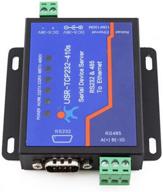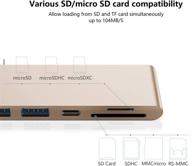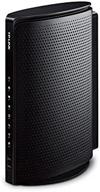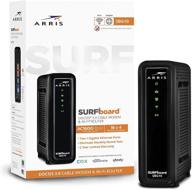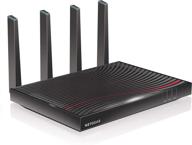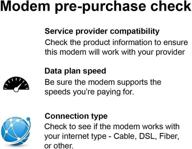Another interesting products
Introduction to Modem Router Combos
A modem router combo, also known as a gateway, is an all-in-one networking device that combines a cable or DSL modem and a wireless router into one physical unit. Modem router combos have become increasingly popular in recent years among home networking enthusiasts and regular internet users alike.
Benefits of Modem Router Combos
- More compact - Takes up less space than separate units
- Fewer cables and power cords
- Typically cost less than buying a separate modem and router
- Easy setup and configuration - Everything is in one box
Top products in 🌐 Modem Router Combos
Key Features to Look For
| Feature | Description |
|---|---|
| Wireless Standard | Newer standards like WiFi 6 provide faster speeds and better performance. |
| Processor | A faster processor means the device can handle more network traffic and connections. |
| Port Configuration | Look for gigabit WAN and LAN ports for optimal wired speeds. |
Setting Up Your Modem Router
Setting up a modem router combo is fairly straightforward:
- Connect the modem router to your internet provider's coaxial or phone cable.
- Power on the device and wait for boot up to complete.
- Access the admin interface using a web browser.
- Configure settings like WiFi name, password, and security.
- Activate and register the device online if required by your ISP.
- Connect wired devices via ethernet ports or connect wirelessly using WiFi.
Tips for Optimal Performance
- Place the device in a central area for best WiFi coverage.
- Keep the modem router away from devices that could cause interference.
- Update the firmware regularly for latest features and security patches.
- Restart the device occasionally to flush memory and clear cache.
- Set up a separate guest network for visitors to keep your main network secure.
With the convenience and performance of modem router combos, it's no wonder they have become the networking device of choice for many households. Following the tips above will help ensure you get the most out of your new modem router.
Similar products
Benefits of Combining Your Modem and Router
In the past, most homes had separate modem and router devices to connect to the internet and create a home network. But modem/router combos have become very popular, offering some great benefits over having two separate units.
Fewer Cables and Power Plugs
A modem router combo condenses everything into one device, so there's just a single coaxial cable from your ISP, and one power cable. This reduces clutter and removing cables strewn across your living room or office.
Space Saving Design
Modem routers are very compact, freeing up valuable desk space or media cabinet real estate. For example, the popular Netgear Nighthawk C7000 is just 7.6 x 2.2 x 6.7 inches.
Cost Savings
Buying a separate modem and router can easily cost $200 or more. A combined unit gives you both for as little as $100, saving you 50% or more upfront.
Easy Setup and Maintenance
With everything in one box, setup is straightforward with no need to configure two different devices. Firmware updates, reboots, and configuration changes are also simplified.
Better Performance
Matching components from a single vendor often provides performance improvements. For example, Netgear's modem routers optimize WiFi throughput between the modem and router functions.
Additional Capabilities
Many modem routers include extra features like built-in voice calling, link aggregation for faster wired throughput, and USB ports for sharing storage and printers on your network.
Potential Drawbacks
- If the device needs replacement, you may have to swap both modem and router.
- Less modular if you want to upgrade specific elements.
- Complex troubleshooting with more components bundled together.
For most home users, the pros of simplicity, cost savings, and performance make a modem/router combo the ideal choice for their networking needs.
Top Modem Router Combos on the Market
All-in-one modem routers have surged in popularity for home networking. Here are some of the top models available based on performance, features, and value.
Netgear Nighthawk CAX80
The CAX80 is one of Netgear's premium modem routers powered by a 1.8GHz quad-core processor. Key features include:
- WiFi 6 support - Up to 6Gbps wireless speeds
- 2.5G WAN port and five 1GbE LAN ports
- Link aggregation support to boost wired throughput
- DOCSIS 3.1 modem with 2.5Gbps capable speeds
With excellent capability for fiber-optic and cable internet plans up to 1Gbps, the CAX80 is a top choice for heavy duty networking.
Asus RT-AX86U
Asus has crammed lots of functionality into the RT-AX86U:
- WiFi 6 wireless with up to 5700Mbps bandwidth
- 1.8GHz quad core CPU
- Adaptive QoS prioritizes traffic
- AiProtection for network security
- Built-in VPN server
With robust wireless coverage and strong wired performance, the Asus RT-AX86U is ideal for large homes and advanced users.
Motorola MG8702
The Motorola MG8702 modem router includes:
- Built-in AC3200 WiFi router with 4x4 MU-MIMO
- 10Gbps maximum modem download speeds
- Four gigabit LAN ports
- Beamforming focuses wireless signal
Providing one of the fastest cable modem connectivity options and powerful WiFi, the MG8702 is a top DOCSIS 3.1 modem router.
Netgear Nighthawk C7100V
Netgear's C7100V modem router provides Combined modem and WiFi speeds up to 2.2Gbps. Other highlights include:
- DOCSIS 3.1 compliant for gigabit cable internet
- Dual core 1.6GHz processor
- lyDMA channel bonding
- Up to 45% faster WiFi than previous gen
The Nighthawk C7100V delivers solid gigabit-class performance at a more affordable price point.
With so many great options available, you can't go wrong choosing one of these top modem router combos to handle your home networking needs.
Choosing the Right Modem Router Combo for Your Needs
With so many modem router combos on the market, it can be tricky to determine which one is the best fit for your home or office needs. Here are some key factors to consider when shopping for a new modem router.
Internet Service Speeds
Match your modem technology to your internet speeds. For basic plans under 100Mbps, a DOCSIS 3.0 modem router is sufficient. For gigabit fiber or cable plans, you'll want a DOCSIS 3.1 or 3.0 modem rated for at least 1Gbps.
| Modem Standard | Maximum Download Speed |
|---|---|
| DOCSIS 3.0 | Up to 1Gbps |
| DOCSIS 3.1 | Up to 10Gbps |
WiFi Performance Needs
Consider your wireless requirements in terms of coverage area, number of connected devices, and network activity types like 4K streaming or online gaming which require more bandwidth. Opt for the latest standards like WiFi 6 for best performance.
Processor and Memory
Faster processors and more RAM provide better overall performance when managing many connected devices and large amounts of network traffic.
Number of Wired Ports
If you have several wired devices, look for a modem router with 4-8 gigabit LAN ports to connect gaming PCs, streaming boxes, NAS drives, printers etc.
Link Aggregation Support
Some modem routers allow combining two LAN ports for faster 2Gbps throughput, useful for devices like network attached storage that transfer large files across your network.
USB Ports
USB ports allow connecting and sharing USB printers and storage drives across your network.
Advanced Features
Consider extra capabilities you may want like AiMesh for wired backhaul, VPN server for remote connections, traffic monitoring and parental controls.
Choosing the right modem router combo means taking into account your current needs and future growth. Focus on speed, performance and features that align with how you use your home or office network.
Setting Up and Configuring Your New Modem Router
Got a new modem router and need to get it installed and working properly on your home network? Here is a step-by-step guide to help you with the setup process.
Physical Connections and Power On
First, use the coaxial cable to connect your modem router to the nearest cable outlet or line from your ISP. For DSL models, use the phone cable instead. Connect the power cord and turn on the modem router.
Before continuing, check the front LED panel to confirm the power, downstream, upstream and internet LEDs are all lit solid. This indicates your physical connections are correct.
Accessing the Web Interface
On a computer or laptop connected to your modem router via ethernet or WiFi, open a web browser. Enter the default gateway IP address typically printed on the label, such as 192.168.0.1 or 192.168.1.1.
When prompted, enter the default login details also found on the label or in the documentation. This is usually just admin for the username and password.
Internet Connection Setup
Run through the quick internet setup wizard, which will guide you through entering your ISP details to activate the modem's connection. Have your ISP name, account username and password handy.
The modem router will begin the connection process, which may take 5-10 minutes. When done, you should have internet access.
WiFi Network Configuration
Next, configure your wireless network name and password. It's best to change the default SSID and passphrase printed on the device. Create a secure password at least 8-12 characters long.
Configure security settings like WPA2 encryption as well. For 5Ghz bands, select a clear channel not congested by neighbors.
LAN Settings
Under LAN or DHCP settings, configure choices like IP address reservation to assign fixed IPs to specific devices or DHCP IP address range.
Set the maximum DHCP lease time to something like 1440 minutes, which is 1 day. This forces devices to renew IPs regularly.
With these basics complete, your new modem router is ready for action! Tweak other settings later to enable extra features.
Troubleshooting Connectivity Issues with Modem Routers
Modem routers are convenient but can sometimes develop connectivity problems that affect your internet access or wireless coverage. Here are some effective troubleshooting tips.
Check the LED Indicators
Inspect the LED display on your modem router. The power, internet, and WAN LEDs should all be lit. If not, verify the coaxial cable from your ISP is firmly connected and all power cables are plugged in.
Reset the Hardware
If the LEDs are correct but you have no internet, try unplugging the power cord from the modem router for 60 seconds. This resets the hardware without losing settings. Plug back in and check for connectivity.
Review Connection Status
Log into your modem router's admin interface and check the connection status page. Look for issues reported such as failed authorization or DHCP errors. If found, contact your ISP to resolve.
Verify DNS Settings
Incorrect DNS servers can prevent web access even if connected. Configure your modem router to use the DNS servers provided by your ISP, typically found in the admin dashboard. Some use 8.8.8.8 and 8.8.4.4 which are Google public DNS servers.
Check for Firmware Updates
Modem router firmware updates often address connectivity issues. Log into the admin panel and check for the latest firmware. If available, download and install it.
Replace Coaxial Cables
Faulty coaxial cables used for the modem router's WAN connection can cause intermittent drops. Swap in a new high quality RG6 coaxial cable to see if it resolves problems.
Adjust Wireless Channel
Nearby WiFi interference can degrade wireless performance. Access wireless settings and switch channels to a less congested option. Avoid channel overlap between 2.4Ghz and 5Ghz bands.
With consistent testing and review of connection metrics, you can isolate and fix most modem router issues. In some cases factory reset or replacement may be needed if problems persist.
Future of Modem Routers - What Features to Expect
Modem routers continue to evolve with new technologies that improve performance and capabilities. Here are some exciting features we can expect to see in the next generation of modem routers.
WiFi 6E Support
WiFi 6E builds on WiFi 6 by adding support for the new 6GHz band. This massive chunk of spectrum can operate multiple 160MHz channels for reduced congestion and latency. Expect future modem routers to take advantage of 6E for blazing wireless speeds.
Multi-Gig WAN Ports
As multi-gigabit internet plans roll out, modem routers will need to keep up. We’ll see more models with 2.5Gbps, 5Gbps or 10Gbps WAN ports to link up with faster fiber and DOCSIS 4.0 cable internet.
Symmetric Gigabit+ Speeds
Future cable and fiber networks will offer symmetrical download and upload - crucial for video calls and cloud usage. DOCSIS 4.0 modems will enable symmetrical multi-gig speeds.
WiFi Mesh Networking
Mesh WiFi built into modem routers provides seamless coverage across large homes. Models like the Netgear Orbi integrate the modem, router and mesh nodes into one system.
AI-Driven Analytics
Sophisticated analytics powered by AI will monitor network activity, troubleshoot issues automatically, and optimize performance. User-aware software will personalize each device’s connectivity.
Smart Home Integration
Modem routers will include deeper integration with smart home ecosystems, acting as a control hub for connected devices like lights, locks, and appliances.
The next wave of modem router innovation focuses on faster speeds, expanded coverage, and greater intelligence. With remote work and learning still on the rise, advanced home networking will only grow more essential.
What is the Use of Amazon Prime for Buyers of Modem Router Combos?
For those looking to purchase a new modem router combo, having an Amazon Prime membership can provide some useful benefits.
Free Two-Day Shipping
One of the core perks of Amazon Prime is free two-day shipping on millions of items. When you need to get a new modem router delivered quickly, this fast free delivery is invaluable.
Rather than waiting over a week for standard shipping, Prime members can have a new modem router in just a couple of days. This reduces downtime if you are replacing a faulty or outdated model.
Free Returns
Amazon Prime also provides free returns on most items. If you purchase a modem router but find it doesn't meet your needs or is defective, you can return it at no cost.
This makes it easy to try out different modems until you find the optimal model for your requirements. Returns remove the risk from choosing a modem router online.
Access to Deals
Amazon Prime members get 30-minute early access to Lightning Deals, which often include steep discounts on popular networking devices. You may be able to score a top-rated modem router for 20% off or more.
There are also Prime-exclusive deals that only members can access. So you may find some reductions on modem routers that non-Prime members won't get.
Streaming Entertainment
Once you get your new modem router set up, the included Prime Video service provides a wealth of TV shows and movies to stream. So you can immediately enjoy your faster internet speeds.
Overall, the shipping benefits, discounts, returns policy, and entertainment access make Amazon Prime a very useful subscription for buyers of modem routers.
What Are The Benefits Of Using A Modem Router Combo??
Using a modem router combo has several benefits, including:
Advantages of Modem Router Combo:
Disadvantages of Modem Router Combo:
Advantages of Separate Devices:
Disadvantages of Separate Devices:
The benefits of using a modem router combo include simplified maintenance, space-saving, lower initial expenses, easy installation, and simple troubleshooting. However, there are also some disadvantages, such as limited control, performance limitation, and less control. On the other hand, separate devices offer enhanced features, greater customization possibilities, cost-effectiveness for replacement, enhanced security, and typically faster connectivity. However, they also have some disadvantages, such as high initial cost and challenging installation. Ultimately, the choice between a modem router combo and separate devices depends on individual needs and preferences.
What Are The Disadvantages Of Using A Modem Router Combo??
Using a modem router combo has some disadvantages, including:
While a modem router combo offers simplified maintenance, space-saving, lower initial expenses, and easy installation, it also has some drawbacks. These include reduced signal strength and slower transfer speeds due to combining two devices into one unit, limited control, and less customization possibilities. Additionally, modem router combos require strategic placement and may be more susceptible to heat-related issues due to their compact designs. Furthermore, they offer less control over security settings and can be more challenging to troubleshoot with your Internet service provider. Ultimately, the choice between a modem router combo and separate devices depends on individual needs and preferences.
What Is A Modem Router Combo Called?
A modem router combo is called a device that combines the functionalities of a modem and a router into a single unit. This device offers a cost-effective and convenient solution for home or office networking, as it is easier to set up and takes up less space on your shelf. Modem router combos are often provided by the cable company for a fee that is part of your monthly bill, but buying your own modem router saves you money in the long run because you no longer need to rent from the cable or internet service provider (ISP). Modem router combos are also known as cable modem router combos, as they are designed to work with cable internet service providers. There are multiple options that are set up to work with all ISPs and cable companies, but before choosing the best modem router combo for you, make sure that it is compatible with your ISP.








